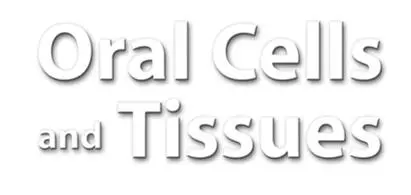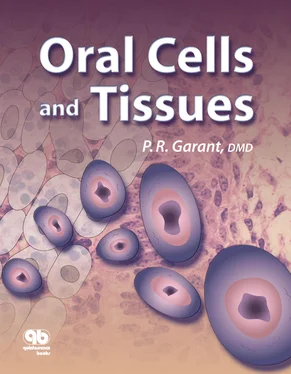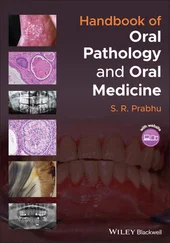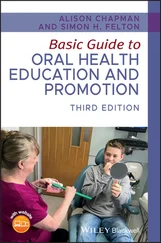Oral Cells and Tissues

Philias R. Garant, DMDProfessor Department of Periodontics School of Dental Medicine State University of New York at Stony Brook Stony Brook, New York

Library of Congress Cataloging-in-Publication Data
Garant, Philias R.
Oral cells and tissues / Philias R. Garant.
p. ; cm.
Includes bibliographical references.
ISBN 0-86715-429-2
1. Teeth—Cytology. 2. Mouth—Cytology. 3. Oral mucosa—Cytology.
[DNLM: 1. Stomatognathic System—anatomy & histology. 2.
Stomatognathic System—embryology. WU 101 G212o 2003] I. Title.
QP88.6.G37 2003
611'.0181—dc21
2003006003

© 2003 Quintessence Publishing Co, Inc
Quintessence Publishing Co, Inc
551 Kimberly Drive
Carol Stream, Illinois 60188
www.quintpub.com
Editor: Arinne Dickson
Internal design and production: Patrick Penney
Cover design: Dawn Hartman
All rights reserved. This book or any part thereof may not be reproduced, stored in a retrieval system, or transmitted in any form or by any means, electronic, mechanical, photocopying, or otherwise, without prior written permission of the publisher.
Printed in Canada
To my wife, Jeanne
Table of Contents
Preface Preface Since the deciphering of the genetic code, scientists have gained enormous insight into how cells and tissues function. It is now evident that our understanding of the structure and function of oral cells and tissues must be based on knowledge of subcellular mechanisms common to most cell types. More than ever, the basic sciences are essential in oral biology, helping us to understand the nature of oral cells and tissues in health and disease. This book seeks to bring our understanding of the basic biology of the oral cavity to bear on the daily clinical practice of dentistry. To accomplish this, whenever possible, the chapters conclude with sections on the basic science and clinical correlations of the information presented. It is my hope that individuals seeking an overview of the cellular components of the oral cavity, whether they are dental students or researchers new to the biology of the oral cavity, will find this book to be a useful framework for their studies. Keeping up with the flood of new information and defining the book’s boundaries were constant challenges. Nevertheless, I have made every effort to make the text as comprehensive and as straightforward as possible for students at any level. I was inspired to write this book because of the pleasure I get from learning about new discoveries and from knowing that there are students who, although anxious to study the purely clinical aspects of their education, see and appreciate the profound beauty of the cells and tissues of the oral cavity. Several individuals deserve acknowledgment for their inspiration and assistance during preparation of this book. My teachers at the Harvard School of Dental Medicine, especially Drs Paul Goldhaber, George Szabo, and the late John Nalbandian, were instrumental in setting me on the path of academic dentistry and making study, research, and discovery a major part of my adult life. Without the encouragement and support of Dean Barry Rifkin, along with the generous resources of Stony Brook University, writing this book would have been impossible. I must also thank Drs James Sciubba and Moon-II Cho for their encouragement and continued insistence that I not give up this project. I am also grateful to all the scientists and publishers who graciously permitted me to adapt and/or reproduce their illustrations for this book. Finally, I am most grateful to my spouse and best friend, Jeanne. Without her help and support I would not have been able to complete my professional education, nor lead a life in academia. I am also grateful to my six children for the love they have shown me.
1Early Tooth Development
Role of the Neural Crest
Development of the Dental Lamina, Enamel Organ, and Dental Papilla
Epithelial-Ectomesenchymal Morphogenetic Regulation of Odontogenesis
Growth and Differentiation Factors That Regulate Tooth Formation
Establishing Coronal Form (Cusp Formation)
Basic Science Correlations
Clinical Correlation: The Human Dentition
2Dentin
Differentiation of Odontoblasts
Secretion of Dentin Matrix
Structure of Mature Secretory Odontoblasts
Composition of the Dentin Matrix
Mineralization of Mantle and Circumpulpal Dentin
Structure of the Odontoblastic Process and Dentinal Tubules
Formation of Intertubular and Peritubular Dentin
Transport Across the Odontoblastic Layer
Innervation of Dentin and Mechanisms of Pain Sensation
Supply of Blood to the Pulp
Cells and Extracellular Matrix of the Dental Pulp
Basic Science Correlation: The Secretory Pathway
Clinical Correlations
3Enamel
Differentiation of the Enamel Organ
Structure of Secretion-Stage Ameloblasts
Biology of the Enamel Matrix
Location and Expression of Amelogenin, Ameloblastin, and Tuftelin Genes
Mineralization of the Enamel Matrix
Structure of Transition-Stage Ameloblasts
Formation of the Papillary Layer
Structure of Maturation-Stage Ameloblasts
Structure of Postmaturation-Stage Ameloblasts
Basic Science Correlations
Clinical Correlations
4Oral Mucosa
Cell Proliferation and Differentiation in Stratified Squamous Epithelia
Structure and Function of the Cornified (Orthokeratinizing) Epithelium: The Epidermal Model
Differentiation of the Oral Mucosa
Basic Science Correlations
Clinical Correlations
5Gingiva
Epithelial Components of the Gingiva
Expression of Keratins in Gingiva
Expression of Cell Surface Adhesion Molecules in Gingiva
Formation of Dental Cuticles
Organization of Gingival Connective Tissue
Supply of Blood to the Gingiva
Innervation of the Gingiva
Flow and Composition of Gingival Crevicular Fluid
Basic Science Correlations
Clinical Correlations
6Periodontal Ligament
Development and General Structure of the Periodontal Ligament
Components of the Extracellular Matrix
Supply of Blood to the Periodontal Ligament
Innervation of the Periodontal Ligament
Читать дальше















